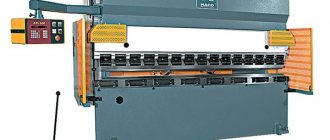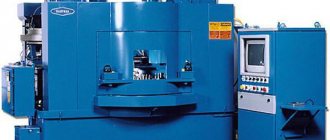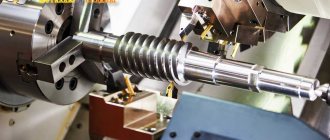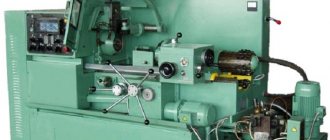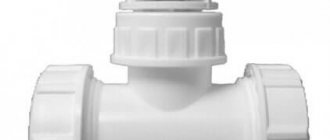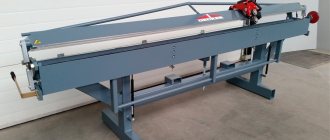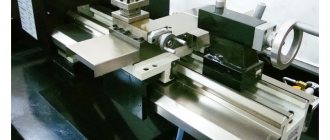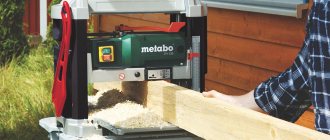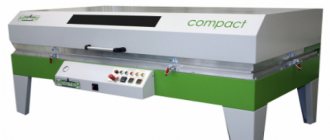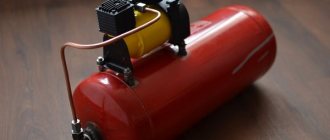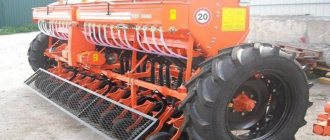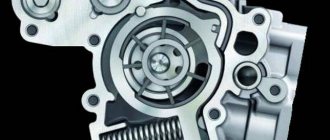What is a boring machine, device and principle of operation
Jig boring machines belong to the category of highly versatile equipment. All complex processing of holes with precise adherence to coordinates is performed on these units. A feature common to all boring machines is the presence of a spindle in a vertical or horizontal direction. The latter is a shaft equipped with a device for holding the tool of the cutting group (drills, cutters, cutters, countersink, tap), and has the ability to move in a linear direction along the axis.
A jig boring machine for working with holes structurally consists of:
- Beds.
- Racks.
- Boring heads.
- Table on skids.
- Traverses.
When working with a part on a machine, it is fixed on the work table, and the processing tool is clamped in the head of the boring spindle. Focusing on the height of the part, set and then fix the head. By moving the table in any of two mutually perpendicular directions, the spindle is installed at the point of the required coordinates. By rotating the spindle, the attached tool processes the workpiece.
Design and device of horizontal boring machine
We will consider the design of horizontal boring machines and their operation using the example of a machine model 2620B with a retractable (710 mm) spindle with a diameter of 90 mm and a radial support on a built-in faceplate (Fig.  .
.
Rice. 8. Main components of a horizontal boring machine
The machine has a fixed front stand mounted on the right side of the base. The spindle head with boring spindle can move up and down within 1000 mm on the guides of the stand. A slide moves along the guides of the base, and on them a table 1300 x 1120 mm, which has longitudinal (1090 mm) and transverse (1000 mm) movement relative to the spindle axis. If necessary, rotational movement is imparted to the table. On the left side of the base there is a rear stand with a steady rest, which serves as additional support for the boring bar when boring long holes. A caliper is mounted on the faceplate in the radial guides, allowing the cutter to process flat end surfaces and recesses.
It is recommended to use this horizontal boring machine for work that is performed primarily using a radial slide, and also allows the passage of the spindle through the boring hole. On this machine you can bore large diameter holes, sharpen grooves, cut threads. A wide range of speeds (spindle from 12.5 to 2000 min-1 - 23 speeds, faceplate from 8 to 200 min-1 - 15 speeds) allows you to process non-ferrous metals (Fig. 9) . Switching the speeds of the spindle and faceplate is carried out by a single-handle mechanism with a device that automatically protects the ends of the teeth from wear during switching. The DC feed drive allows you to change the feed during cutting without switching any clutches or gears and control the fine and fast installation movements of the working bodies through a special electrical device - operator. The machine is controlled from the main and auxiliary consoles. To move all the working parts of the machine manually there is a central steering wheel.
Rice. 9. Kinematic diagram of a horizontal boring machine model 2620B
During finishing, gaps in the table and headstock guides are automatically eliminated by special spring devices. The rear pillar is also blocked. Anti-friction linings in the guides increase the smoothness of movement and reduce wear on the guides. Clamps of moving units are single-handled, centralized.
The spindle and faceplate are driven by a two-speed asynchronous motor. Changing the rotation speed of the main drive is achieved by switching the motor windings and two triple blocks of gears. The direction of rotation is changed by reversing the motor.
When the faceplate is turned on, the boring spindle also rotates at a speed 1.58 times greater than the faceplate. Switching speeds can be performed both when the spindle is stopped and when the spindle is idling.
The feed drive for working, slow and installation movements of the moving parts of the machine is carried out from a DC motor with a control range of R = 1600.
The kinematic chain of the faceplate support has a planetary device that allows the support to move during rotation of the faceplate. The axial movement of the boring spindle occurs from a rack and pinion gear located in the tail part of the spindle head. To turn on the feed, you need to press the corresponding organ, set the switch on it, set the desired feed and turn it on with the button.
The machine has two remote controls: stationary and portable. The stationary console is designed to control the machine from the main workplace, the portable one is used at remote points and has the same main controls as the stationary one. The machine is equipped with attached optical devices for measuring the coordinates of the headstock and table in the transverse direction, the rest of the rear post and the angles of rotation of the table through 90° with an accuracy of 0.02 mm at a radius of 500 mm.
Whole millimeters are measured with a line-marked pointer. Tenths and hundredths of a millimeter are measured on the microscope's circular scale.
The 2620B machine is equipped with a large number of different locking devices.
The ability to use various tools on horizontal boring machines has made it possible to widely equip them with CNC systems. Here they took two paths: they equipped universal machines with program control and created on the basis of these machines multi-operational processing centers with large-capacity tool magazines. In the first case, positional program control ensures the movement of the executive bodies along three coordinates: X - lateral movement of the table; W—longitudinal movement of the table; Y - vertical movement of the spindle head. In the second case, automatic tool change is also used. The second option for modernizing horizontal boring machines has become the most widespread
Purpose of the equipment
Jig boring machines are designed to process holes with strict adherence to the center-to-center distances between them and orientation relative to the base surfaces. In this case, the counting occurs in a rectangular coordinate system without the use of additional means of guiding the tool. Such machines are used in both individual and mass production.
The main work on such machines includes:
Machine coordinate system
- drilling, boring holes (rough, finishing);
- turning cylindrical surfaces from the outside;
- processing the ends of holes, as well as their deployment, countersinking;
- milling of flat surfaces;
- thread formation;
- measuring parts.
In addition, the equipment allows you to drill holes in conductors and body elements, where the utmost accuracy of their relative position is important. Diamond boring machines are designed for boring cylinders, bushings, connecting rods and other engine parts.
Standard machine coordinate system
In addition to boring work, the machines can be used to perform markings, control dimensions, and check center-to-center distances. Using rotary tables (included with the equipment), holes are machined, the location of which is determined by the polar coordinate system, as well as inclined and mutually perpendicular holes.
Boring machines are equipped with optical-based reading devices. This makes it possible to count within whole and fractional parts of the coordinate size. The accuracy with regard to center-to-center distances reaches about four thousandths of a millimeter. More accurate devices are equipped with a digital distance display system and allow the operator to set coordinates with an accuracy of 0.001 mm.
Boring device
The invention relates to the field of mechanical engineering, tooling for metal-cutting machines. The boring device contains a three-jaw self-centering lathe chuck, which has a spiral-rack movement mechanism, in which the cams are made in the form of tool holders, and small conical wheels. For ease of adjustment, it is equipped with an additional conical wheel installed in the chuck body with the possibility of rotation from the indicated small conical wheels, and coupled with an additional conical wheel along the thread and mounted coaxially with the chuck body with a screw. In this case, the screw is connected to the chuck body by means of a pin and a keyway with the possibility of axial movement during rotation of the additional conical wheel and carries a sleeve with a conical lateral surface, fixed by tool holders in a state adjusted to the size. 1 ill.
Single-cutter boring chucks [1] are known, used for machining large-diameter holes. Their common disadvantage is the low processing productivity due to the small allowance cut off by one cutter.
The closest thing to this invention is a boring device [2], based on the design of a three-jaw self-centering chuck according to GOST 2675-71, in which the jaws are replaced by tool holders having bases for installing cutters of a certain length. Adjustment to the required size of the machined hole is done by securing a calibrated shaft of the appropriate diameter with tool holders. This device [2] is a prototype of the invention: The prototype has the following disadvantages. The first is the inconvenience of adjustment, which is expressed in the fact that when adjusting to a size, the operator needs to hold the calibrated shaft with one hand and rotate the key with the other to secure it with tool holders. The second disadvantage of the prototype is that it does not allow adjustment for processing holes of the same nominal size, but with different deviations: for each hole it is necessary to have a calibrated shaft of a certain size. The objective of this invention is to provide ease of setup and the ability to configure for processing holes with similar sizes without replacing the shaft secured by tool holders. This objective of the invention is solved by the fact that a boring device with a three-jaw self-centering lathe chuck having a spiral-rack movement mechanism, in which the cams are made in in the form of tool holders, and small conical wheels, equipped with an additional conical wheel installed in the chuck body with the possibility of rotation from the specified small conical wheels, and coupled with the additional conical wheel along the thread and installed coaxially with the chuck body with a screw, while the screw is connected to the chuck body by means of pin and keyway with the possibility of axial movement during rotation of the additional conical wheel and carries a sleeve with a conical side surface, fixed by tool holders in a state adjusted to the size. The drawing shows a longitudinal section of the boring device. It consists of a housing 1 in which a wheel 2 is installed with the possibility of rotation, on the end surface of which there is a thread in the form of an Archimedes spiral, a small conical wheel 3 resting on a compression spring 4, installed with the possibility of its rotation and axial movement and occupying a free state the most distant position from the axis of the device, an additional gear bevel gear 5, meshing with a small bevel gear 3, at its closest position to the axis of the device, a screw 6 connected to the body 1 by means of a keyway and a pin 7 and threaded with an additional gear bevel wheel 5, mounted movably on the body 1. At the front end of the screw 6, between the tool holders 9, there is a replaceable sleeve 8 with a conical side surface, which has a size scale and is fixed in the required position by the tool holders 9. Adjustment to the size is carried out as follows. In accordance with the size range, to which the nominal size of the hole being machined refers, bushing 8 of the required size is installed on screw 6 and secured with nut 10. A key is inserted into the socket of the small bevel wheel 3, compressing the spring 4, it is inserted into engagement with an additional bevel wheel 5, the key is rotated, the required axial position of the sleeve 8 is reached, the small bevel wheel 3 is disengaged from the wheel 5, the small bevel wheel 3 is rotated with the key and wheel 2, secure bushing 8 with tool holders 9. The invention is implemented by using parts used in the mechanical engineering of cam lathe self-centering chucks in accordance with GOST 2675-71 with a spiral-rack mechanism for moving the cams. In this case, the cams are replaced with tool holders, a hole is made in the body for installing a pin 7, a shank 11, a screw 6, a set of bushings 8, an additional gear 5, a small bevel gear 3, a spring 4 are made, and the device is assembled. The technical result is achieved by the fact that The proposed boring device has an additional conical wheel and a screw located coaxially with the device, connected to each other by thread so that the rotation of the additional conical wheel provides axial movement of the screw, at the front end of which a replaceable conical bushing is installed, fixed in the required axial position, providing a given setting size. Sources information1. Ponomarev V.F. Handbook of a lathe-borer. - M.: Mashinostroitel, 1969, p.284.2. Zheleznov G.S., Singeev S.A. Boring device. Mashinostroitel, 1977, No. 12, p.42.
Claim
Boring device with a three-jaw self-centering lathe chuck having a spiral-rack movement mechanism, in which the cams are made in the form of tool holders, and small conical wheels, characterized in that it is equipped with an additional conical wheel installed in the chuck body with the possibility of rotation from the specified small conical wheels , and coupled with an additional conical wheel along the thread and installed coaxially with the chuck body with a screw, wherein the screw is connected to the chuck body by means of a pin and a keyway with the possibility of axial movement during rotation of the additional conical wheel and carries a sleeve with a conical shape, fixed by tool holders in a state adjusted to size lateral surface.
DRAWINGS
Types of jig boring machines
The jig boring machine comes in two main types of designs: single-column and double-column. Single-column models are equipped with a cross table, on which the fixed workpiece has the ability to move along mutually perpendicular lines in the horizontal plane. The feeding of the processing tool is carried out due to the vertical movement of the spindle.
Dimensions of the working space of a single-column jig boring machine
Two-post machines also have a table for securing workpieces. In this model, the table moves on a slide along a longitudinal line between the racks, and the boring head on a spindle moves along a traverse in the longitudinal direction. The spindle in this case also has the ability to move along the vertical.
Two-column jig boring machine - dimensions
Depending on the level of automation, jig boring machines are:
- with an indication and a coordinate system;
- with built-in CNC;
- with the function of automatic change of tools and workpieces;
- with the function of connecting additional equipment to the CNC, for example, a rotary table.
The most basic parameter of any jig boring machines is the diameter of the boring spindle. The larger it is, the larger the machine in overall dimensions.
Main spindle components
Device of a diamond boring machine
The diagram of a horizontal diamond boring machine with a hydraulic feed drive, model OS-4750, is shown in Fig. 14. The machine consists of a frame, a hydraulic cylinder 4, hydraulic communications, a guide lubrication tank, an oil distributor, a drive roller, a left-hand drive, a bridge 7, a table, a hydraulic drive, a dynamic braking device, an electrical cabinet and spindle heads 5.
Rice. 14. Kinematic diagram of a diamond boring machine with a hydraulic feed drive : 1 - main drive motor; 2, 3 — replaceable main drive pulleys; 4 — hydraulic cylinder of the feed drive; 5 - spindle head; 6 — boring bar; 7 - bridge.
The machine does not have a gearbox, and the main movement drive consists of an electric motor 1 and a V-belt drive. The cutting speed is selected by the diameters of pulleys 2 and 3. Boring bar 6 is attached with its flange to the spindle of spindle head 5. A boring cutter is installed in the boring bar. A device for securing workpieces is installed on bridge 7, which receives movement from the initial loading position at a feed rate using a water cylinder 4. The feed amount is regulated by turning the throttle. The workpiece is fixed in the device using a hydraulic cylinder through a system of levers
060
Special fixtures and boring heads
Boring cutters with cylindrical shank for jig boring machines with carbide inserts
A jig boring machine processes parts using various removable cutting attachments. The cutter itself is a product whose working part is made of tool steel. The element is secured in the head using a shank holder.
Structurally, the cutter holder is designed so that the cutter can move freely on a special slider. The slider is connected to the hardware of the jig boring machine through a distribution bar. If it is necessary to move the cutter under the influence of a control signal, an automatic element in the bar is activated, after which the spindle head shifts to one side or another.
Another operation where a special device is used is the manufacture of a matrix for a mold (boring). The adjustable head acts as a universal tool. This element is equipped with a groove for moving the slider and a ring regulator with a scale printed on it. Adjustment (preliminary and fine) is carried out mechanically using two screws.
Equipment classification
Boring units have some design features. Depending on the type of work performed, equipment can be specialized or universal.
The main feature of units of this kind is the spindle (can be located in both horizontal and vertical positions), with the help of which the axial feed is driven. Since the equipment is adapted to perform different tasks , the workpiece often goes through a full processing cycle. It is important that the product does not need to be moved between several machines.
Therefore, boring machines are in particular demand in the mechanical engineering industry, where there is an urgent need for constant complex machining of parts. The main characteristic that influences the level of performance is the spindle cross-section. The working tool is fixed in it.
Models of single column machines
All modern models of boring units have a rectangular table with the ability to move in a horizontal plane in two directions - longitudinally and transversely. The table movement is controlled by electric motors with precise stroke control in a wide range of modes.
Jig boring machine 2E450A (analogue of the outdated model - 2D450)
This equipment is designed to process holes with axes positioned with extreme precision. Dimensions are set in a rectangular coordinate system. The machine is equipped with a rotary table for working with parts in the polar coordinate system. Readout devices are assembled on optics, which allows you to count whole and fractional parts of a coordinate value.
Jig boring machine 2D450
The machine allows you to do:
- Drilling holes;
- Finish milling;
- Control of linear dimensions, center-to-center distances and markings;
- Thread cutting;
- Operations with inclined holes and those located mutually perpendicular;
- Grooving of end planes.
Jig boring precision machine 2431
Ultra-precise universal machine for working in a coordinate system using optical equipment. Capable of processing parts weighing up to a quarter of a ton, performing finishing operations on them, ensuring extreme accuracy of the distances between holes and surfaces being processed. The machines are used in radio engineering, instrument making, watchmaking, and tool shops.
The equipment can have holes:
- Drill;
- Drill out;
- Boring;
- Deploy.
And also trim the ends, accurately mark templates, control linear dimensions and center-to-center distances.
CNC coordinate boring machine – 2440SF4
Single-column vertical multi-purpose unit for processing medium-sized parts. It is designed to perform work in single and serial production. The machine can produce control and measuring instruments, reference samples, and also carry out precise measurements.
Additional equipment controlled by CNC can be installed on the basic model:
- Tool store with automatic tool replacement system;
- Rotary table, tiltable overhead;
- Universal grinding head.
Double-column jig boring machine (model 2455AF10)
The unit is a jig boring and measuring machine widely used in industry. Possibilities when working with matrices, jigs and molds:
- Drilling holes;
- Countersinking;
- Deployment;
- Boring.
In addition, you can perform fine, semi-finish milling of shaped contours and flat surfaces. When modifying the equipment with a rotary table of a flat or universal design, measurement of angular coordinates is available. Due to the powerful support, the machine has increased strength, rigidity and a low temperature coefficient of expansion, which ensures more precise processing of products.
Layout of metal-cutting machines
Home » Articles » Professionally about metalworking » Metal-cutting machinesWe recommend purchasing:
Installations for automatic welding of longitudinal seams of shells - in stock!
High performance, convenience, ease of operation and reliability in operation.
Welding screens and protective curtains are in stock!
Radiation protection when welding and cutting. Big choice. Delivery throughout Russia!
Metal-cutting machines are more diverse than any other technological machines. They are distinguished by technological purpose and cutting tools, by size and standard varieties, by control systems and degree of automation, and, in addition, by layout. The variety of layouts is a consequence not only of a variety of technological tasks, sizes and shapes of processed parts, but also of the development of machine tool designs and processing methods, and the very relative nature of the shaping movement contains a variety of possible options for the movements of the workpiece and tools, and, consequently, the layouts of machine tools.
The layouts of special machines are especially varied, but the type of universal machines is also continuously replenished with machines with new layouts that differ significantly from traditional ones.
Traditional layouts of milling, boring, turning and other universal machines have come a long way of improvement due to the need to use new tools, expand versatility, and increase rigidity due to the intensification of cutting conditions.
The formation of modern machine tool layouts was not uniform and simultaneous, nor was the development of cutting tools. The layout of the lathe took shape earlier than others. Some features of modern layouts of boring, milling and other machines can be seen in machines built in the first half of the 19th century.
There is reason to believe that the formation of the structure of the layout of most modern universal machine tools was completed by the beginning of the 20th century, and subsequently only their improvement occurred. A number of new layouts of universal machine tools appeared in the second and third quarters of this century. For example, milling machines appeared, the layout of which allowed them to successfully compete with traditional cantilever milling machines. Semi-automatic lathes with new layouts are rapidly spreading, and with the development of program control, drilling machines with cross tables, etc. appeared.
Further development of the layout of universal machine tools is associated with the emergence of multi-operational machines (machining centers).
The search undertaken by many organizations and firms has led to the emergence of a large number of completely new layouts that most fully meet the conditions for performing various operations on one machine. However, the quality of these layouts still requires appropriate analysis.
Increasing requirements for the quality of machine tools in connection with the general increase in precision in mechanical engineering, the production of parts from difficult-to-machine alloys, the emergence of new tool materials, as well as the improvement of software control, forces us to look for ways to improve the quality of layouts as an important component of the quality of machine tools.
At the same time, the use of separate drives in machine tools, including those with program control, the introduction of rolling guides, hydrostatic guides and other structural elements opens up wide opportunities for improving traditional and creating new layouts.
The task of intensifying production processes and improving the quality of industrial products in relation to metal-cutting machines must be solved comprehensively, taking into account all possible factors, including such an important factor as the layout of the machines. The science of metal-cutting machines (machine tool science)
Thanks to the work of a number of Soviet scientists, it has been deeply developed and significantly contributes to improving the technical level of domestic machine tools. Thanks to the work of famous scientists - Academician V.I. Dikushin, Honored Workers of Science and Technology of the RSFSR, Doctors of Engineering. science prof. N. S. Acherkan and D. N. Reshetov, Doctor of Engineering. science prof. V. A. Kudinov and others - the Soviet machine tool industry has an extensive fund of scientific materials on the design of machine tools. The kinematics of cutting on machine tools was studied by Dr. Tech. science prof. G.I. Granovsky, and the doctrine of the kinematic structure of machine tools was developed in the works of prof. N. S. Acherkana, prof. G. M. Golovin and Dr. Tech. science prof. A. A. Fedotenka.
There are few works in the literature devoted to the issues of machine tool layouts. In the science of metal-cutting machines, there is an insufficiently researched area concerning one of the most critical stages of machine tool design - the stage of constructing the layout. This stage of preliminary design is carried out by the most qualified designers, who are guided mainly by experience and intuition. The lag in the development of the theory of layouts of metal-cutting machines has its reasons. The first reason is the view of the basic layout of universal machine tools as something immutable, taken for granted, and not subject to change. This view is based on tradition. The second reason is the lack of a research language—a way to refer to any arrangement. The existing system of designating models of universal and special machine tools has other goals and cannot be used as a language for studying layouts.
The third reason lies in the complexity and versatility of the issues that arise when justifying the construction of a layout, in the difficulty of formalizing many intuitive ideas that guide leading designers, bureau heads and chief designers of SKVs and factories. At the same time, this reason in the domestic machine tool industry dictates the need to formalize the design with its subsequent automation using a computer.
Another reason is the well-known uncertainty and ambiguity of the very concept of machine layout. This concept is often associated with the technological diagram of a machine tool, the kinematic structure, the supporting system, and finally, simply with the design of the machine. Meanwhile, layout is a category corresponding to a certain stage of preliminary design, following the development of a technological diagram and justification of technical characteristics. It precedes the development of the design of the units.
Reflecting the kinematic structure of the machine, the layout does not replace the latter and requires, when constructing, solutions to issues that go beyond kinematics. Depending on the complexity and other features of the kinematics of the machine, the construction of the layout is carried out before or after the development of the kinematic diagram.
Layout
- a concept more capacious than the supporting system of the machine, which is only the physical skeleton of the layout that supports the guides.
The concepts of structure, universality, type of layout are not compatible with the concept of a supporting system. At the same time, when we talk about the rigidity of the layout, it is the rigidity of the supporting system that is meant, therefore, these concepts, although not unambiguous, complement each other. Layout
is a system of arrangement of components and controls of a machine, differing in structure, proportions and properties. Machines with different designs of components (assembly units) can have the same layout, and, conversely, machines with the same designs of main components (for example, with aggregate power heads) can have different layouts. Therefore, the concepts of design and layout should not be identified. Moreover, in order to improve the quality of the machine at all stages of its design, it is necessary that at the stage of constructing the layout, purely layout quality factors should be identified and analyzed. To achieve this, factors related to the layout should be kept as separate as possible from those related to the subsequent development of the subassembly design.
A complete distinction between the layout and the design is not required and is not possible, if only because when constructing the layout and performing the corresponding calculations, some data on the type and design of the guides is necessary, and some reference dimensions are determined only as a result of a preliminary structural study. Nevertheless, identifying layout factors and consciously operating with them allows the designer to additionally influence the quality of the designed machine. Both identification and opposition of layout and design are undesirable. Thus, the concept of machine layout has independent meaning and can be the subject of special research.
The construction of the machine layout has its own successive steps, or stages. The fundamental stage is the development of a technological scheme for constructing a machine, when, in accordance with the technological task, the required composition of working and installation movements, the number of spindles, the degree of versatility of the machine, the form (parallel or sequential) of centralization of processing, the number of working and loading positions, etc. are determined. This stage is a diagram that can be called a technological layout.
A number of fundamental studies and monographs are devoted to technological layouts.
The subsequent stages of constructing the layout of the machine are the coordinate layout, which reveals the composition and order of combination of coordinate movements in the machine; basic layout, which determines the type of machine based on the types of basic components and other characteristics; structural layout, which specifies the design and some other layout features. Further steps to refine the layout are also the specific standard size and model of the machine, which are associated with the determination of all the main dimensions, design and technological capabilities of the machine.
The theory of coordinate, basic and structural layouts, as well as the theory of dimensional proportions of the layout, has not yet been developed. There is a significant gap between scientific knowledge on the theory of technological layouts and scientifically based methods for calculating and designing kinematic chains, assembly units and machine parts. The theory of layouts—the componetics of machine tools—could fill this gap.
The theory of layouts could provide significant assistance to designers at the most critical stage of design and ultimately help improve the quality of machine tools. This theory could answer the question of whether the endless growth of the type of machine tools is fatally inevitable, indicate ways to improve the layout of designed machines and areas of optimal use of existing layouts, and answer many other questions related to the tasks of intensifying production and improving the quality of products. One of the ultimate goals of the layout theory may be the automation of layout design using a computer.
Creating a theory for the layout of metal-cutting machines requires the efforts of many people and considerable time. The primary tasks in creating a theory of layouts are, apparently, the development of a research language and the definition of layout quality factors. The first task involves finding a way to write any layout of machine tools that would have a structural basis and some mathematical properties, this would allow the use of this kind of language not only to designate layouts, but also as a research tool. Without this, it is impossible to analyze various layout structures, explore the totality of existing ones and the possibility of the emergence of new layouts. The second task - identifying layout quality factors - is associated with the need to compare layouts and improve their quality. Clear identification and quantitative expression of layout factors are necessary when calculating the layout in order to analyze the influence of these factors on the static and dynamic quality characteristics, as well as for the purpose of operating with them when optimizing the size and proportions of the layout. Formalizing layout factors could be a significant step towards automating layout design.
Although significantly different, the two objectives are not incompatible. Layout quality factors can be contained in the layout structure itself, and the manifestation of structural properties depends, in turn, on the implementation of layout factors. Therefore, solutions to both problems are designed to complement each other.
Vragov Yu.D. “Analysis of layouts of metal-cutting machines”
Purpose and classification of drilling and boring machines
The main types of drilling and boring machines: vertical drilling single- and multi-spindle (Fig. 2); radial drilling (Fig. 3); horizontal drilling for deep drilling (Fig. 4, a) and horizontal centering (Fig. 4, b).
According to the classifier, drilling and boring machines are assigned to the second group, within which they are divided into the following types: 1 - vertical drilling; 2 — single-spindle semi-automatic; 3 - multi-spindle semi-automatic machines; 4 - coordinate boring; 5 - radial drilling; 6 - horizontal boring; 7 - diamond boring; 8 - horizontal drilling; 9 - different drilling machines.
Drilling machines are designed to perform the following work: • drilling through and blind holes (Fig. 1, a), while ensuring the possibility of obtaining a surface roughness parameter of at least 12-13 quality and Ra = 6.3...15 microns; • drilling holes - increasing the diameter with a twist drill (Fig. 1, b);
• countersinking, which makes it possible to obtain a higher quality and a lower value of the hole surface roughness parameter compared to drilling (Fig. 1, c) - accuracy 11…13 quality, Ra= 10…15 µm;
• boring of holes, carried out with a cutter on a drilling machine (Fig. 1, d);
• countersinking, performed to obtain cylindrical and conical recesses and chamfers for the heads of bolts and screws at the holes (Fig. 1, e);
• reaming of holes, used to obtain the necessary parameters of accuracy (7...11 quality) and roughness (Ro= 1.25...5 µm) (Fig. 1, f);
• smoothing, carried out by special roller mandrels, or flaring, which has the purpose of compaction - smoothing the ridges on the surface of the hole after unfolding parts made of duralumin, electron, etc. (Fig. 1, g);
Rice. 1. Work performed on drilling machines: a - drilling holes; b - drilling; c - countersinking; g - boring; d - countersinking; e - deployment; g - ironing; h - cutting internal threads; and—counting
• cutting internal threads with a tap (Fig. 1, h); when using a combined tool, complex surfaces are obtained;
• counterbore - cutting the ends of external and internal bosses and bosses (Fig. 1, i).
These types of work do not exhaust the capabilities of drilling machines; other operations are also performed on them.
When drilling, the main cutting modes are: feed s; cutting speed V= πDn/1000, m/s (where D is the tool diameter, mm, n is the tool rotation speed, s-1); cutting depth t= 0.5D when drilling and t= 0.5(Dd) when drilling, countersinking, reaming, d is the initial diameter.
Rice. 2. Layouts of vertical drilling machines (A - single-spindle; B - multi-spindle): a - tabletop; b - medium-sized on a box-shaped basis; c - medium size on a round base; g - heavy; d - machines with permanent spindles having one common bed; e - machines with adjustable articulated spindles
Feed is the movement of the drill along the axis in one revolution (or in one revolution of the workpiece, if it is rotating). The following types of feed are distinguished: s0 - per revolution of the drill, mm/rev; 5 — minute feed, mm/min.
Rice. 3. Types of radial drilling machines: a - stationary general purpose; b - with a column moving along the frame guides; c - mobile on rails; g - portable
Rice. 4. Layout of machines for deep drilling: a - horizontal drilling machine for drilling rotating parts; b - horizontal drilling machine for drilling fixed parts
These types of feeds are interconnected by the following ratios:
s = s0n60.
In addition to serially produced drilling machines, machine tool factories produce many special machines. These machines are usually designated by conventional serial numbers.
